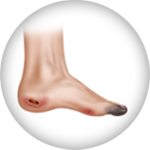Non-healing Wounds

Symptom Details
People with peripheral vascular disease (PVD) may start out with mild symptoms, or no symptoms. Without treatment, conditions such as varicose veins, tired heavy legs and pain at rest can eventually turn into more severe complications as the disease progresses. More than 500,000 to 2 million people in the United States suffer from leg ulcers, or non-healing wounds.8 Conditions such as superficial venous insufficiency (SVI) and deep venous disease (DVD) can reduce blood flow to the extremities and can make it difficult for the body to heal itself. These sores usually develop on the leg above the ankle.2 Arterial disease such as critical limb ischemia (CLI) can also cause wounds to heal slowly. This advanced form of arterial disease can result in ulcers below the ankle as well as kissing ulcers, or non-healing wounds between toes. Non-healing wounds are almost always accompanied by redness, swelling and pain. Left untreated, these sores are at risk of developing an infection, which can lead to serious, long-term health complications, including amputation of the limb.3 Symptoms can range depending on the progression of the underlying PVD disease and how far it has progressed.4,5,6 If you are experiencing any of these symptoms consistently, it is important to take the step and seek help from your doctor right away.
Venous Causes and Symptoms
More than 80 percent of leg ulcers are caused by venous disease.9 When the veins in your legs are not working efficiently to carry blood back to the heart, the valves have become damaged and blood flows the wrong way. This back-up of fluid causes blood to pool in the leg and builds increased pressure on the vein walls. This condition can lead to skin damage and non-healing wounds. Venous wounds develop above the ankle when the blood pools in the ankles. The leaky veins result in pooling of inflammatory substances in the blood, which in turn irritate the skin chronically and lead to wounds.
Arterial Causes and Symptoms
Arterial disease can also cause non-healing wounds. As fatty plaque builds up inside the artery, it narrows and restricts blood flow to the limbs. This damage to blood vessels can result in non-healing wounds.
Risk Factors

Not all people with PVD disease will develop non-healing wounds. But there are certain risk factors that can increase the chances of developing the severe condition. These risks include:7,8
What to Look For
Non-healing wounds usually do not begin on their own. A person may notice swelling, varicose veins, or many other symptoms relating to PVD disease. As the condition advances open sores can develop.
Arterial Signs
The Rutherford Classification is a common system that is widely used to diagnose and identify the severity of arterial disease as it progresses.
Rutherford Classification10
| Stage 0 | Stage 1 | Stage 2 | Stage 3 | Stage 4 | Stage 5 | Stage 6 |
| No symptoms | Some exercise pain after walking long distances | Exercise pain that occurs more frequently at shorter distances | Severe exercise pain that happens frequently after a short distance | Pain in the legs, calves, buttocks that occurs despite rest | Leg ulcers begin to develop | Severe non‑healing wounds can lead to gangrene or tissue loss |
Venous Signs
Non-healing venous wounds, caused by Venous Disease, may present these signs
When to See a Doctor
If you have a wound that persists and fails to improve, it is crucial to take the step and seek help. These wounds will not heal on their own without medical treatment. It is important to get properly diagnosed, especially to reduce the risk of infection and long-term complications. Talk to your doctor, or use our tool to locate a doctor to consult for a diagnosis..
Associated PVD Diseases
Helpful Resources

PVD Doctor
Discussion Guide
Get helpful tips and advice on how to talk to your doctor about a PVD screening.

Patient Brochures
Third-Party Resources
Helpful Websites
Blogs
Apps
A mobile app built by cardiologists, to simplify understanding of most cardiac and peripheral vascular conditions and treatments.
Find a Doctor
If you think you are experiencing pain at rest, it is important to get help. Talk to your doctor, or use our tool below to find a specialist near you.
This tool is not inclusive of all specialists. Consult with your insurance provider to find specialists that are covered within your network.
Are You a Healthcare Professional?
Find out how to register your practice with us.
1. Iqbal et al. “Management of Chronic Non-healing Wounds by Hirudotherapy.” World Journal of Plastic Surgery. 2017 Jan; 6(1): 9–17. 2. Hess, Thomas. “Checklist for Factors Affecting Wound Healing.” Advances in Skin & Wound Care: April 2011 – Volume 24 – Issue 4 – p 192. 3. Guo et al. “Factors Affecting Wound Healing.” J Dent Res. 2010 Mar; 89(3): 219–229. 4. Frykberg et al. “Challenges in the Treatment of Chronic Wounds.” Adv Wound Care (New Rochelle). 2015 Sep 1; 4(9): 560–582. 5. “6 Signs You Have an Infected Wound.” Advanced Tissue. n.d. 6. Walshe C. “Living with a venous leg ulcer: a descriptive study of patients’ experiences.” J Adv Nurs. 1995 Dec;22(6):1092-100. 7. Grey et al. “Venous and arterial leg ulcers.” BMJ. 2006 Feb 11; 332(7537): 347–350. 8. Margolis DJ, Bilker W, Santanna J, et al. “Venous leg ulcer: incidence and prevalence in the elderly.” J Am Acad Dermatol 2002;46(3):381-6. PMID: 11862173 9. Simon et al. “Management of venous leg ulcers.” BMJ. 2004 Jun 5; 328(7452): 1358–1362. 10. Hardman et al. “Overview of Classification Systems in Peripheral Artery Disease.” Semin Intervent Radiol. 2014 Dec; 31(4): 378–388.
Disclaimer
The opinions and clinical experiences presented herein are for informational purposes only. Individual results may vary depending on a variety of patient-specific attributes and related factors. Dr. Raghu Kolluri has been compensated by Philips for his services in preparing and providing this material for Philips further use and distribution. We offer links to third-party websites that may be of interest to our website visitors and in no way, represent any affiliation or endorsement of the information provided on those linked websites. These links are provided solely for your convenience and to assist you in learning more information on this topic. However, Philips does not control, endorse or guarantee the accuracy of the information contained on the linked sites. In addition, Philips makes no representations or warranties of any kind with regards to any third-party websites or information contained therein. If you have any questions or concerns about the information on the linked third-party websites, please contact the third-party websites directly.









